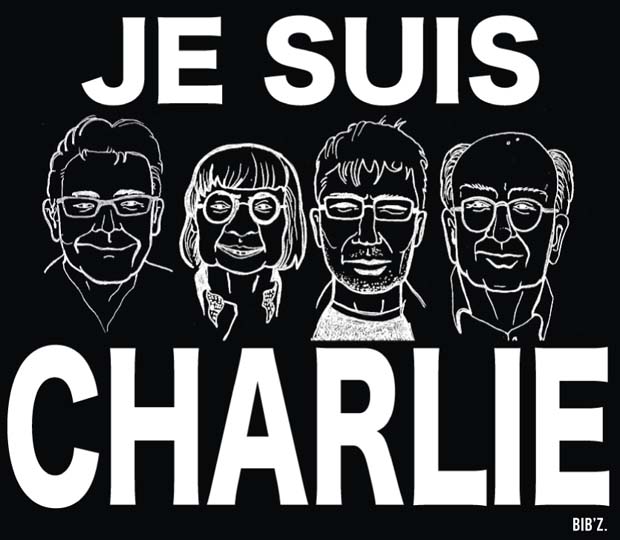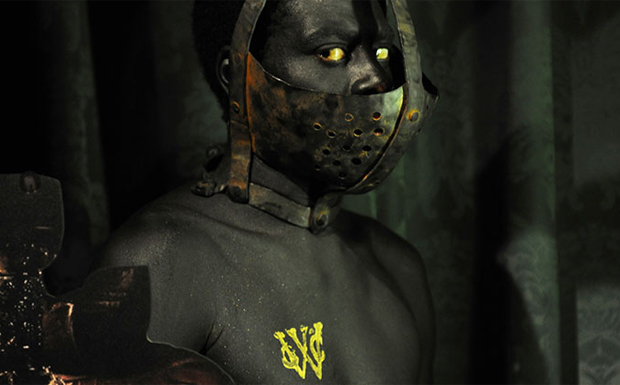Index relies entirely on the support of donors and readers to do its work.
Help us keep amplifying censored voices today.

They Are Charlie: a tribute to cartoonists Bernard Verlhac aka Tignous, Jean Cabut aka Cabu, Stéphane Charbonnier aka Charb and Georges Wolinski by French artist Bib’z.
Armed men attacked the offices of French satirical magazine Charlie Hebdo on Wednesday. They killed two police officers and ten members of the magazine’s staff, including cartoonists Stéphane Charbonnier aka Charb, Jean Cabut aka Cabu, Georges Wolinski and Bernard Verlhac aka Tignous. The magazine has been targeted in the past over its controversial cartoons, including ones featuring the Prophet Mohammed. In 2011, the office was firebombed.
Index has condemned the appalling attack, saying there is nothing that could justify it. “The ability to express ourselves freely is fundamental to a free society. This includes the freedom to publish, to satirise, to joke, to criticise, even when that might cause offence to others. Those who wish to silence free speech must never be allowed to prevail,” added Index CEO Jodie Ginsberg.
Throughout the day, people from across the world have showed solidarity using the hashtag #JeSuisCharlie, while many cartoonists have supported the magazine through their art.
“Cartoonists are among the first people targeted by extremists and fundamentalists for poking fun at the sacred cows of our societies. Humour and satire are tools that close minded extremists have little defence against except by the use of weapons and murder,” Dr. Robert Russell, executive director of Cartoonists Rights Network International said in a statement.
“I feel very sad, horrified and hopeless after hearing this news,” Indian cartoonist Kanika Mishra, who drew the piece above, told Index. “One year ago, I was facing such threats when I made cartoons on [charismatic guru] godman Asaram but I never took those threats seriously. I never knew some blind followers and extremists can go to such extent. Whole world should be united against such horrific attacks on freedom of speech and its high time that we should start talking about a global policy for protecting the rights of every artist in the world.”
Martin Rowson, cartoonist for The Guardian, The Independent and Index among others, added that “we need above all else to laugh these blood-stained clowns back into the dustbin of history, and urgently.”
Below is a selection of the cartoons being shared on social media.
De tout coeur avec Charlie Hebdo. pic.twitter.com/8KwTipn3Wp
— PLANTU (@plantu) January 7, 2015
Charlie Hebdo. Nooit opzij. pic.twitter.com/MJwGKPQ8jU — Joep Bertrams (@joepbertrams) January 7, 2015
Horrible attack.Cartoonists across the world are uniting against bloodshed and violence. @ibnlive @cnnbrk pic.twitter.com/QtTe9INeU9
— Neelabh Banerjee (@NeelabhToons) January 7, 2015
The little weapon! #CharlieHebdo #cartoon pic.twitter.com/VFFZD2f8Rz — Satish Acharya (@satishacharya) January 7, 2015
Can’t sleep tonight, thoughts with my French cartooning colleagues, their families and loved ones #CharlieHebdo pic.twitter.com/LqIMRCHPgK
— David Pope (@davpope) January 7, 2015
Hommage de notre dessinateur @na_dessinateur aux victimes de #CharlieHebdo pic.twitter.com/2AgMZyc7Yq — BFMTV (@BFMTV) January 7, 2015
— El Jueves (@eljueves) January 7, 2015
Sad Khartoon! I’m Just a Muslim .. From a Muslim #Cartoonist RIP #CharlieHebdo pic.twitter.com/27Vt2RvAGs — ALBAIH (@khalidalbaih) January 7, 2015
Spanish cartoonists are sharing this image with the message: “To arms, companions!” via @sicevis #CharlieHebdo pic.twitter.com/hQqPJMQeV5
— Jennifer Hattam (@TheTurkishLife) January 7, 2015
Comment dessiner aujourd’hui ? Comment ne pas dessiner aujourd’hui ? pic.twitter.com/cNtJY6e7MK — Martin Vidberg (@Vidberg) January 7, 2015
Adieu Cabu, Wolinski, Tignous, Charb…le dessin de Zep. N’arrêtez jamais de dessiner. #CharlieHebdo pic.twitter.com/F9KInDR8AL
— Adeline Francois (@a2linefrancois) January 7, 2015
#CharlieHebdo pic.twitter.com/15O4YC2KWg — Ruben L. Oppenheimer (@RLOppenheimer) January 7, 2015
This article was published on 7 January and updated on 8 January 2015 at indexoncensorship.org
Index on Censorship has been exploring artistic freedom of expression and contemporary forms of censorship in the UK. Who or what controls what is sayable in the arts? Who has a voice in the arts? Do the answers vary as we move around the different member nations of the UK?
Looking at our culture through the prism of artistic freedom of expression opens up questions about the power relations between artists, venues, audiences, the police, the media and community interest.
Our initial case study Beyond Belief – theatre, freedom of expression and the police offered insight into how these relationships are often played out in the present day. Deepening our exploration, conferences in London in 2013 and Belfast in early 2014, have been followed by a programme of work in Wales in the latter half of this year. Art Freedom Wales was Index’s exploration of whether Wales is enjoying its right to artistic free expression.
Across all three projects, it is becoming clear there are massive pressures on what is sayable in the arts–rifts around what is acceptable to funders, to the audience, to public opinion, or even health and safety. It is also clear that there are significant questions around the issue of access to artistic expression–for established and aspiring artists, as well as the public at large. Events this past summer at the Barbican around Brett Bailey’s Exhibit B have underlined recurring questions around the role of the police and the media in shaping what gets to be seen.
In 2015, Index is planning to explore the state of artistic freedom in Scotland before holding a state of the nations event which will bring together key players to discuss how to reinforce support for artistic expression across the UK.
ArtFreedomWales
Over the past few months Index’s project ArtFreedomWales has hosted a series of online discussions with artists from across Wales–established artists, emerging artists and artists working in Welsh. You can catch up with everything that’s been said here.
These discussions, and the issues they raised, informed our approach to a Free Speech Hearing in Cardiff on 27 November. As a culmination of the project, the hearing invited practitioners from across art forms alongside policy makers and cultural gatekeepers to come together to discuss the question “Is Wales enjoying its right to freedom of artistic expression?”
To open the hearing, Index invited Turkish playwright Meltem Arikan, an established artist, with direct experience of censorship who is now living in exile in Wales, to survey the Welsh arts scene from the eye of an outsider.
This was followed with an array of evidence volunteered from across Wales, short presentations surfacing a number of topics from offence to rumour, and self-censorship to cultural education.
Moving from the stage to discussion between peers, major themes and concerns were examined in more detail in breakout sessions.
Finally, a panel discussion featuring Dai Smith (Arts Council Wales), John McGrath (National Theatre Wales), David Anderson (Museums Wales), Lleucu Siencyn (Literature Wales) and Elen ap Robert (Pontio) asked how leading organisations in Wales might take on some of the issues raised during the afternoon?
This article was posted on Dec 10, 2014 at indexoncensorship.org

Exhibit B (Photo: © Sofie Knijff / Barbican)
Exhibit B, The City, the Tricycle Theatre… Several high profile cases this past summer have ignited a debate about artistic censorship in the UK.
Join us as part of RADAR Festival at the Bush Theatre in London to explore the rights of the artist to free expression, to examine the role of arts institutions in defending and promoting free expression, and to ask the question: is it ever better to censor than to cause offence? The event features:
WHERE: Bush Theatre, London, W12 8LJ
WHEN: Thursday 13 November 2014, debate 9.00-10.00pm (following show 7.30-8.30pm)
TICKETS: £10 (early bird, including show) at www.bushtheatre.co.uk or 0208 743 5050 (box office)
Follow the discussion via the hashtag #RADAR2014
Co-produced by Index on Censorship and the Bush Theatre as part of the RADAR Festival.